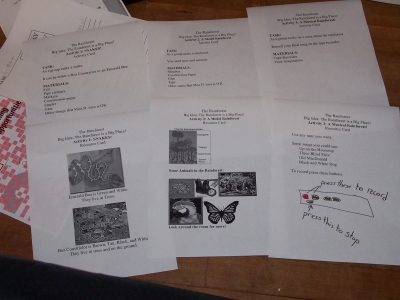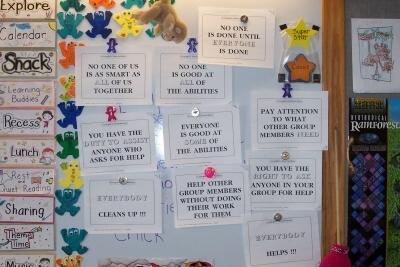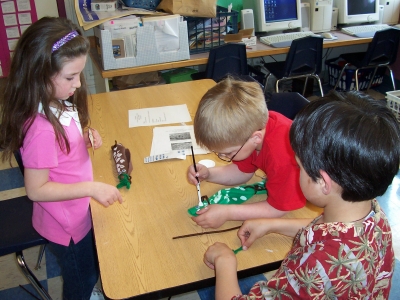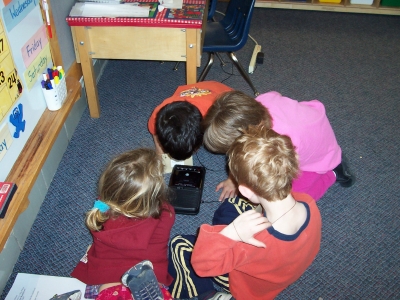|
"Spoon feeding in the long run teaches us nothing
but the shape of the spoon." ~ E.M. Forster
| During the Spring of 2004 I was asked to prepare
children to work in special cooperative groups for a Complex Instruction
rotation. Complex Instruction (or C.I.) is a type of groupwork that
uses roles and tasks rich in multiple abilities to help children work together
to complete a single project. Another part of C.I. is assigning competence
to low-status students to raise their status in the class and to raise
their confidence in themselves. This form of cooperative grouping can have
a major effect on everyone in the class. My C.I. rotation was on
the Rainforest in a full-day kindergarten. There were 22 students
in the rotation. One of the students was a non-english speaker that
had moved from Korea and started school about 2 weeks prior to the rotation.
The 22 children were split into 6 groups of either 3 or 4 (PC 2a2).
Each project was done by 2 groups at a time. |

|
To the left is a copy of the activity and resource cards for the rotation.
Each card told the student what was to be expected of them for their activity.
The three activity cards that I had were making snakes out of felt, pipe
cleaners, and whatever the children's imaginations could think of, making
a diorama of the rainforest with both plants and animals, and creating
a song about the rainforest using at least one fact. The resource
cards all have pictures and words on them so that they would be assessable
to all students (PC 2a3), including the non-speaker, who I had found
out was a beautiful artist. |
| The picture to your right is the norms of C.I. I used all of
them for my rotation and in going over my process and my data I felt
that I should have only used 2 or 3 for this young class (PC 2d), especially
since we didn't have much time to prepare for this rotation. The
norms in C.I. are used to help with managing the groups. The norms
are simple ideas that will help any group or community to learn together.
Some of the norms are: Everybody cleans up, No one is good at all of the
abilities, No one of us is as smart as all of us together, and Everyone
is good at some of the abilities. The norms are vague and address
most needs in a group, such as making sure that the classroom is a safe
and healthy place to learn cooperatively in (PC 3a, 3b).. In
my future classroom I will address these norms at the beginning of the
year and use them to help in classroom management throughout the year. |
 |
 |
To the left is a picture of the brown group working on their
snakes. Each one of them is wearing a badge denoting their role in
the group. In many groups the terms: facilitator, recorder, reporter,
materials manager, and harmonizer is used as roles in C.I. groups.
I used simpler names for my groups. I used: Talker (makes sure that
everyone talks and participates), Listener (makes sure that everyone listens),
reporter (makes sure that their sharing gets prepared), and peace keeper
(helps to solve problems in each group). These roles help to make each
student an active participant in the group, they also help to make sure
that every child gets to learn the information. (PC 3a) |
| The video to the right is one of the groups that got right to work
the first day and needing very little help becoming a good group.
What you see in the video is the little boy saying that he needs a particular
color of marker, the little girl with dark hair gets up and gets it for
him, he uses the polite words "Thank You" after receiving the marker.
The little girl was responding to the norm, "Pay attention to what other
group members need. While this group worked well as a group, you might
hear the other groups in the background not working so well together.
After each day of C.I. the class comes together to discuss how the rotation
went. We spent time that day discussing how to work in a group
and how to make sure that the group is successful. We discussed making
sure that each child gets an equal opportunity and is allowed a chance
to learn too. (PC 4c) |
|
Vignette #1a
The first child that I would like to write about is
Faith. Faith surprised me by scoring the lowest on the status order.
To me she seemed like a child who wasn’t really outgoing, but I always
saw her playing with children. This can be misleading as they are
instructed to include everyone. After I found out her status on the
chart, I watched her closely and realized that she is always the one joining
the group and is usually trying to assert herself in the group and is being
ignored. At times this child seems to be lethargic and at those times
she doesn’t move unless she has to. She is very sure of herself and
likes to be in charge in groups which can cause discord in the groups.
At most times the fact that she is so low doesn’t seem to bother her, however,
when she can not find anyone to play with her and it makes her sad and
she points out the rules so the groups have to let her play if they want
to follow the rules. This girl is always thinking and
I think that it tends to come across to the other children as slow.
During one math lesson she used sophisticated language and her constant
thinking that allowed her to make an observation that no one else had noticed.
“I noticed that the ‘y’ has the most less amount out of all of them.”
This statement was asked to be repeated by the teacher for the students.
Faith doesn’t enjoy going out to recess. She
doesn’t get ready to go unless she is forced. She will make excuses
as often as she can. Her lethargy and her excuses about recess seem
to be directly attuned to her position in the status order. I believe
this when she finds something she is excited about. At these times
she seems to leave her status order in the class behind as she forgets
everything around her and she moves so quickly and her face just lights
up. I love seeing that face.
Vignette #1b
During this rotation I watched as Faith tried
to join into groups and give her ideas. Most noticeable for me was
the song creation. She had many ideas and was working hard to share
them. However her group was trying to shut her out. This was
the only time that I effectively assigned competence and in the aftermath
I noticed the other children finally listening to her suggestions and actually
trying to make some of them work. When they played their song for
me, her face was beaming with pride and the rest of her group enjoyed the
final product as well. Faith’s good thinking and her memory really
helped her group through this activity. During their next activity
the next day, Faith was given much more freedom in the creative process.
She was allowed to voice her opinion and help to shape the product as she
saw it. |
This is an excerpt from my C.I. paper. For the assignment we
wrote about 4 children before and after the C.I. rotation. This particular
child the lowest status child in the classroom. (This was found out during
a previous assignment where we interviewed each child and found who they
thought had the highest academic and social status). I knew that
Faith loved to sing and she is an excellent thinker, so I thought that
the singing activity would be good for her and it was because I was able
to assign compentence to her for her thinking and brainstorming abilities
that she was showing, but her group was ignoring. I found a drastic
change the following day in her groups behavior to her. This wasn't
the case around the board, but in this case a large change occured that
allowed her to gain status in her groupmates eyes.

|
| At the end of my CI unit, while looking back, I began to
realize that CI is really a great tool in a classroom. With more
practice I will be able to effectively work it into my future classroom
with good efficiency. The students were having fun, but they were
also able to create things that they thought they couldn’t. An example
of this is Pearl, Faith, David, and Ian’s group. On the first day
they were making snakes, they came up to me and said, “I don’t see how
we can make snakes out of this stuff.” They were looking for direct
instruction. I looked at them and told them that I wanted them to
problem solve. What were some ways that they could create a snake
out of squares of felt and pipe cleaners and all the other materials that
they could use? I left them on there own and about 5 minutes later
they had figured out what they were going to do. This was amazing
to see. I hadn’t done any open-ended projects yet in the semester
and it was nice to allow creativity to flow among all students.(PC 2e) |
|